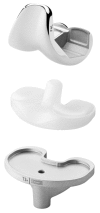Early Clinical Outcomes of a New Posteriorly Stabilized Total Knee Arthroplasty Prosthesis: Comparisons with Two Established Prostheses
- PMID: 28854763
- PMCID: PMC5596401
- DOI: 10.5792/ksrr.16.047
Early Clinical Outcomes of a New Posteriorly Stabilized Total Knee Arthroplasty Prosthesis: Comparisons with Two Established Prostheses
Abstract
Purpose: We sought to determine whether early clinical performance of new posterior stabilized (PS) knee system, the Vega-PS (Aesculap), is better than that of two established total knee arthroplasty (TKA) prostheses, the E.motion-PS (Aesculap) and the Genesis II (Smith & Nephew) in terms of functional outcomes, patient satisfaction, and incidence of adverse events.
Materials and methods: We compared the clinical outcomes of 206 consecutive TKAs using Vega-PS with those of 205 TKAs using E.motion-PS and 216 TKAs using Genesis II at 2 years of follow-up.
Results: Overall, the knees with the Vega-PS had better functional outcome scores than the knees with the E.motion-PS, but had similar outcome scores to the knees with the Genesis II, as evident from the American Knee Society knee score (94.2 vs. 92.5 vs. 93.2), Western Ontario McMaster Universities Osteoarthritis (WOMAC) stiffness index (1.8 vs. 2.3 vs. 2.0), WOMAC function index (11.8 vs. 16.8 vs. 18.5), Short Form 36 (SF-36) physical component summary score (41.9 vs. 39.3 vs. 41.6), and SF-36 mental component summary score (50.0 vs. 45.8 vs. 46.9). Patient satisfaction was higher in the Vega-PS and Genesis II groups than the E.motion-PS group. No notable group differences were found in terms of the incidence of adverse events.
Conclusions: The Vega-PS, a newly developed PS fixed bearing prosthesis, had comparable or superior clinical performance in comparison with the two established fixed or mobile bearing PS prostheses.
Keywords: Arthroplasty; Knee; Outcome assessment; Prosthesis design; Replacement.
Conflict of interest statement
No potential conflict of interest relevant to this article was reported.
Figures


Similar articles
-
Differences in outcome after cruciate retaining and posterior stabilized total knee arthroplasty.J Orthop Surg (Hong Kong). 2019 May-Aug;27(2):2309499019848154. doi: 10.1177/2309499019848154. J Orthop Surg (Hong Kong). 2019. PMID: 31104589
-
Functional Outcomes of a New Mobile-Bearing Ultra-Congruent TKA System: Comparison With the Posterior Stabilized System.J Arthroplasty. 2015 Dec;30(12):2137-42. doi: 10.1016/j.arth.2015.06.011. Epub 2015 Jun 14. J Arthroplasty. 2015. PMID: 26187388
-
Early clinical outcomes of floating platform mobile-bearing TKA: longitudinal comparison with fixed-bearing TKA.Knee Surg Sports Traumatol Arthrosc. 2010 Jul;18(7):879-88. doi: 10.1007/s00167-009-0985-8. Epub 2009 Nov 28. Knee Surg Sports Traumatol Arthrosc. 2010. PMID: 19946671 Clinical Trial.
-
Comparison between standard and high-flexion posterior-stabilized rotating-platform mobile-bearing total knee arthroplasties: a randomized controlled study.J Bone Joint Surg Am. 2010 Nov 17;92(16):2634-42. doi: 10.2106/JBJS.I.01122. Epub 2010 Oct 15. J Bone Joint Surg Am. 2010. PMID: 20952606 Clinical Trial.
-
Comparison of Anterior-Stabilized and Posterior-Stabilized Total Knee Arthroplasty in the Same Patients: A Prospective Randomized Study.J Arthroplasty. 2019 Aug;34(8):1682-1689. doi: 10.1016/j.arth.2019.03.062. Epub 2019 Mar 31. J Arthroplasty. 2019. PMID: 31005431 Clinical Trial.
Cited by
-
Long-Term Outcomes of High-Flexion Design Total Knee Arthroplasty with a Short Posterior Flange.Clin Orthop Surg. 2024 Apr;16(2):251-258. doi: 10.4055/cios23133. Epub 2024 Feb 8. Clin Orthop Surg. 2024. PMID: 38562641 Free PMC article.
-
Management and clinical outcomes of periprosthetic fractures after total knee arthroplasty with a stem extension.Medicine (Baltimore). 2019 Jun;98(25):e16088. doi: 10.1097/MD.0000000000016088. Medicine (Baltimore). 2019. PMID: 31232950 Free PMC article.
-
Posterior-stabilized inserts are preferable to cruciate-substituting ultracongruent inserts due to more favourable kinematics and stability.Knee Surg Sports Traumatol Arthrosc. 2018 Nov;26(11):3300-3310. doi: 10.1007/s00167-018-4872-z. Epub 2018 Feb 19. Knee Surg Sports Traumatol Arthrosc. 2018. PMID: 29459998
-
Mid-term clinical and radiological results do not differ between fixed- and mobile-bearing total knee arthroplasty using titanium-nitride-coated posterior-stabilized prostheses: a prospective randomized controlled trial.Knee Surg Sports Traumatol Arthrosc. 2019 Apr;27(4):1165-1173. doi: 10.1007/s00167-018-5095-z. Epub 2018 Aug 7. Knee Surg Sports Traumatol Arthrosc. 2019. PMID: 30088030 Clinical Trial.
-
The Vega advanced third generation posterior stabilized total knee arthroplasty system enables the restoration of range of motion for high demanding daily activities - A 5-years follow-up study.PLoS One. 2024 May 13;19(5):e0302885. doi: 10.1371/journal.pone.0302885. eCollection 2024. PLoS One. 2024. PMID: 38739584 Free PMC article.
References
-
- Hoffmann C, Gosheger G, Gebert C, Jurgens H, Winkelmann W. Functional results and quality of life after treatment of pelvic sarcomas involving the acetabulum. J Bone Joint Surg Am. 2006;88:575–82. - PubMed
-
- Nicholls MA, Selby JB, Hartford JM. Athletic activity after total joint replacement. Orthopedics. 2002;25:1283–7. - PubMed
LinkOut - more resources
Full Text Sources
Other Literature Sources
